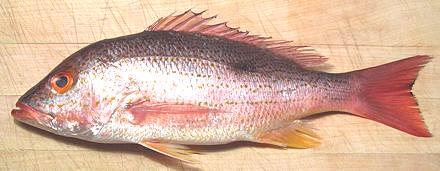 [Lutjanus synagris]
[Lutjanus synagris]
This true Snapper is found in the Gulf of Mexico, Caribbean and West Atlantic from North Carolina to southern Brazil. It can grow to 24 and nearly 8 pounds but is commonly around 10 inches. The photo specimen was 13 inches and weighed 14-5/8 ounces. This snapper is less well known than the Pacific Red Snapper so sells at a significantly lower price (in this case 2011 US $3.99 vs $6.49 at the local Philippine fish market). There have been some reports of ciguatera poisoning from eating this fish caught in tropical reef environments. This fish is IUCN rated NE (Not Evaluated) and is not considered threatened.
More on the Snapper Family.
Lane Snapper has delicate flesh with a delicate flavor. The flesh is near white with darker areas just under the skin, but these do not have a strong taste. It is flavorful enough to interest fish lovers but not so strong as to deeply offend those who prefer their fish white and bland. Use delicate sauces so as not to overwhelm the flavor.
Cooking: This fish is suited to delicate recipes where its flavor will not be overwhelmed. Skinless fillets fry very nicely in a little olive oil but need a light dusting of rice flour so they hold together. You don't want much more than that or it will hide the excellent flavor. Fillets hold together well enough for a light poaching but boiling in soup will break them into crumbs.
Scales: The scales are large but scrape off rather easily with only moderate flying about.
Cleaning: Cleaning this fish doesn't present many problems. You'll find there's not a lot in this fish. but the esophagus is strong and needs to be cut with kitchen shears. The swim bladder is rather tough but needs to be scraped off to get to the blood works under it. The gills pull rather hard so use your long nose pliers.
Skin: The skin has no strong or "off" flavor but shrink is extreme, so it needs to be removed for most cooking methods. The skin is thin, but fairly strong, so fillets can be skinned easily using the long knife and cutting board Method. The skin can be added to the pot when making stock.
Fillet: This is a very easy fish to fillet with easy to follow bone structure. There should be almost no flesh left behind. I usually remove the head before filleting. Tilt the knife to get under the gill covers to get as much flesh as possible. There will be a couple small bones you'll need to cut with kitchen shears, and then the backbone. When filleting, minimize bending the flesh as it tends to flake apart.
When I get to the rib cage, I just cut the ribs away from the backbone with kitchen shears and pull them from the fillet with long nose pliers. They pull easily and cleanly. There are just a few centerline spines which need to be pulled straight forward.
Yield: A 14-5/8 ounce fish yielded 6-3/4 ounces of skin-on fillet (46%), and 6-1/4 ounces skinless (43%). A larger fish would probably yield a higher percentage.
Stock: The head, bones, fins and skins make a very fine light soup stock. There is almost no oil, but what there is should be removed (use your gravy separator). This stock is so good that to make a fine fish soup a shake of salt is all the ingredients you need. For details see our Fish Stock page.
sf_snapplz 110205 - www.clovegarden.com